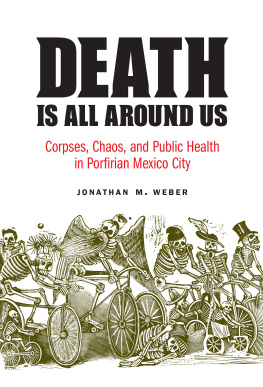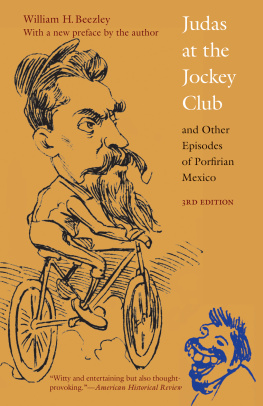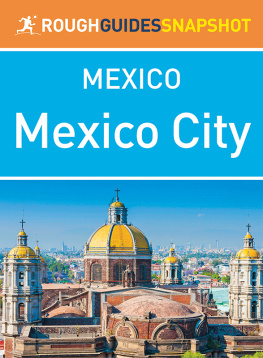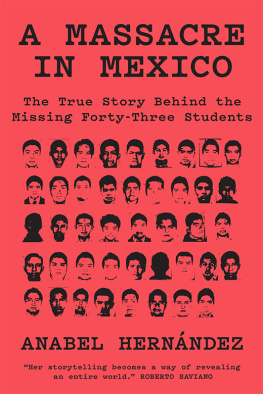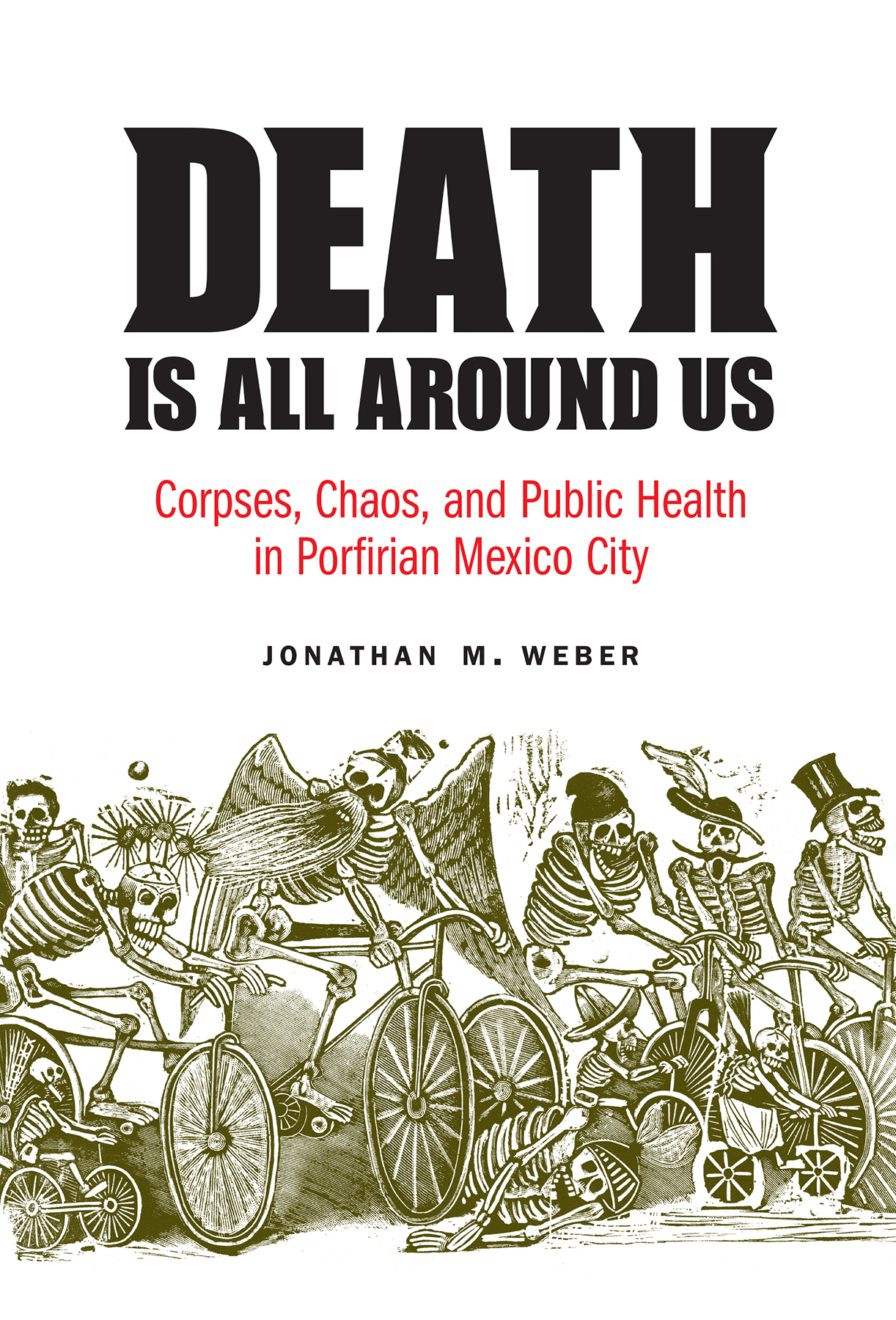
An important contribution to our understanding of Mexico City and the Porfiriato, Webers book furthers understanding of the history of medicine, public health, technology, and modernity.
Heather McCrea, author of Diseased Relations: Epidemics, Public Health, and State-Building in Yucatn, Mexico, 18471924
Fascinating.... Readers will be delighted at the stories that Weber has brought to light through a thorough combing of underutilized archives even as they will be reminded of the ubiquity of death and corpses in late nineteenth-century Mexico.
Andrae Marak, professor of history and political science at Governors State University
A highly innovative contribution to the histories of death, public health, and mortuary science.
Kathryn A. Sloan, author of Death in the City: Suicide and the Social Imaginary in Modern Mexico
The Mexican Experience
William H. Beezley, series editor
Death Is All Around Us
Corpses, Chaos, and Public Health in Porfirian Mexico City
Jonathan M. Weber
University of Nebraska Press | Lincoln
2019 by the Board of Regents of the University of Nebraska
Cover designed by University of Nebraska Press; cover image is from the interior.
All rights reserved
Library of Congress Cataloging-in-Publication Data
Names: Weber, Jonathan (Jonathan M.), author.
Title: Death is all around us: corpses, chaos, and public health in Porfirian Mexico City, 18871913 / Jonathan M. Weber.
Description: Lincoln: University of Nebraska Press, [2019] | Series: The Mexican experience | Includes bibliographical references and index.
Identifiers: LCCN 2018032363
ISBN 9780803284661 (cloth: alk. paper)
ISBN 9781496213440 (pbk.: alk. paper)
ISBN 9781496214324 (epub)
ISBN 9781496214331 (mobi)
ISBN 9781496214348 (pdf)
Subjects: LCSH : Public healthMexicoMexico CityHistory. | Corpse removalsMexicoMexico CityHistory.
Classification: LCC RA 452. M 6 W 43 2019
DDC 363.7/5097253dc23 LC record available at https://lccn.loc.gov/2018032363
The publisher does not have any control over and does not assume any responsibility for author or third-party websites or their content.
To Campbell Paige
Contents
Figures
Maps
Writing a book is a wonderful but lonely exercise. However, I was lucky enough to have a supportive wife, family, friends, and mentors, both in Mexico and the United States, who made all the long hours bearable. I owe an enormous amount of debt to Dr. Ronald E. Doel and Dr. Kristine C. Harper, who have helped me grow not only as a historian but as a person and more importantly, a writer. I cannot say enough positive things about both Dr. Doel and Dr. Harper, and anyone who has had the opportunity to meet them and work with them instantly knows that they are both class acts and great role models for their students. In particular, both have helped shaped the book, never failing to provide detailed comments on my drafts that drastically improved the direction and quality of the final product.
I am also grateful to my parents and in-laws here in the United States and my faux parents in Mexico City. My mom and dad (and my in-laws, Stacy and Vits) supported my decision to pursue a graduate degree, the research that inspired this book. Moreover, the research for this book wouldnt have been possible without the wonderful generosity of Hctor and Glafira in Mexico City, who welcomed me into their home in 2005 when I visited for the first time to conduct research for my masters thesis. They treated me like one of their children, and without their help and kindness, I would never have been able to finish the project. I must also thank Professor Monica Rankin for graciously taking me under her wing, inviting me to writing sessions alongside her and a handful of other well-established scholars at the University of Texas at Dallas. Monica has also been instrumental in helping me shape the narrative and pushing me to reexamine the archival evidence to determine how I wanted to tell the story of dead bodies and technology in the Porfiriato. Additionally, I want to thank Professors Elaine Carey, Linda Arnold, Claudia Agostoni, and Ana Mara Carrillo for helping me conduct research and providing guidance over the years while I was in Mexico City. Linda, in particular, is a great person and historian whose countless suggestions and unmatched knowledge of archival holdings in Mexico City is a valuable resource for any young scholar, and I cannot thank her enough. The staff of the Archivo General de la Nacin, Archivo Histrico de la Ciudad de Mxico, Archivo Histrico de la Secretara de Salubridad y Asistencia, and the Archivo Histrico de la Universidad Nacional Autnoma de Mxico, thank you for your help in locating archival material (some in the official records catalog and some not), photography assistance, and overall kindness. Thank you to Jenn, who read through early versions of the manuscript and offered her suggestions; your help was much appreciated. I want to say a special thank you to everyone at the University of Nebraska Press, in particular, Bridget, Emily, Rosemary, Elizabeth, and I am sure countless others. In talking with Bridget early on in the project, she was genuinely excited about it, and her interest and belief in the project and her support is greatly appreciated. I am also thankful to Sarah C. Smith, my copyeditor, who has made the final product much stronger than the original. I was especially touched by her personalized notes scattered throughout the text, which just made me feel good when I read through the edits.
Lastly, I want to thank my wife for her patience over the years. Since my masters thesis, Kendra has stood by me, even when I wanted to quit several times. Truthfully, I do not know if I would have reached this point if she had not pushed me outside my comfort zone and taught me that if you really love something, you have to work at it. As I edit, during the World Cup, weve now seen three of them together and Im aiming for at least twelve more with you. Thanks for being the best mom, partner, friend, and person I could ask for. You always believe in me, even when I doubt myself, and I am grateful for you. I love you.
According to the World Health Organization, a specialized agency of the United Nations concerned with international public health, as of 2016 the leading cause of death in Mexico is diabetes. Roughly 14 million Mexicans have diabetes, a number that has nearly tripled since 1990, and expert projections do not see the number slowing down anytime soon. In fact, epidemiologists project that by 2030 17 percent of Mexican adults will end up diabetic, and by 2050 half of all Mexican adults could suffer from diabetes at some point during their lifetime.
Additionally, the lack of green spaces, available fitness equipment, and clear running spaces, especially in Mexico City, has exacerbated the public health problem. Heavy smog, cracked sidewalks, congested streets, and crime, as Barrientos puts it, have kept people from exercising, thus contributing to the rise in the number of diabetes cases. Barrientos and other medical experts also believe that for too long health officials put the responsibility of diet and exercise squarely on the broadening shoulders of their patients. As Barrientos sees it, and he is not alone, the government must intervene more directly when it comes to diet and exercise if Mexicos diabetes problem is going to improve.
Experts further believe that Mexicos physicians are ill equipped to handle chronic disorders that require lifelong medical attention and monitoring, which requires a different skill set then what they are learning in medical school. Compared to infectious diseases, Dr. Gerry Eijkemans, the head of the World Health Organization in Mexico, noted, it is easier to reduce a mosquito population than to change a lifestyle, to change the way a society is basically organized (to encourage) people to consume unhealthy food with lots of fat and sugar. This attempt to shape the lifestyle choices of its citizens in the name of protecting their health is nothing new in Mexico. During the presidency of Porfirio Daz (187680, 18841910), he and his state officials believed they had the ability to improve the lives of Mexicans through science and technology in order to solve Mexicos public health problems. But getting all citizens to adopt new ways of celebrating and mourning death would prove to be a Sisyphean effort.
Next page
